Resource management has become very important in recent years. One reason is that often more people are required than are available; another that the required qualifications change at an ever-quicker pace. Hence, most innovative companies need a professional solution to master the challenges of tactical resource planning. This is the only road to:
- Optimal employment of the existing resources
- Identifying new positions and qualifications in good time
- Adequate staffing of these positions
Often, companies try to resolve these resource management challenges with methods and tools from project and portfolio management. This seems natural, as innovations are made in the context of projects. Plus, resource scheduling is an essential component of project management.
Unfortunately, this often does not work out as intended. Or it can take a very long time before successes in resource management actually become visible.
This is because only a fraction of companies works in a pure project organization. In such a case, project managers can put together their project teams at their own discretion. The team members of the project would have no responsibilities outside of projects. However, most companies work in line or matrix organizations or in a hybrid of the two. In this environment, the huge challenges of tactical resource planning become apparent.
This article will introduce you to the following topics:
- Overview of the three areas of resource management
- Different perspectives for team leader and project manager
- Different forms of organization – Different issues
- Resource management challenges according to PMO Survey 2020
- Conclusion
Note: By tactical resource planning, we mean the formation of teams for projects with suitable staff as well as the coordination of resource use between team leader and project manager. Due to the nature of their roles, the team leader and the project manager do not always pursue the same objectives. This makes tactical resource planning one of a company’s most challenging tasks.
Unfortunately, there is not THE ONE right way to establish a system for project and resource management. In this article, you will benefit from our many years of experience.
With the knowledge gained, you will be able to develop your own ideas and your own road to a suitable solution for tactical resource planning.
And another note: Throughout this article, the terms resource management and resource planning are used interchangeably.
Let us distinguish the different terms first.
Special Download: 3 Important Points for your Tactical Resource Planning (PDF file)
Please fill in the form.
* Required Fields | Data Protection
Overview of the Three Areas of Resource Management
Resource management is a broad field. In the context of project management, it can be divided into three areas. These we define as follows:
Strategic resource planning / Capacity planning
This encompasses the long-term planning of the staff’s qualifications and capacities. Its aim is to master the running and future projects in accordance with the company’s strategic focus. The question is:
Which, and how many, resources:
- Will be necessary for the upcoming projects and operations?
- Will need to be obtained or trained?
In most cases, portfolio managers take on this task. They need the current requirements at the level of skills / capabilities from the project managers. The team leaders have to provide the available staff with the required qualifications. We will not elaborate on strategic resource management, aka capacity planning, here.
Special Download: Capacity Planning – 4 Important Success Factors (PDF file)
Please fill in the form.
* Required Fields | Data Protection
Tactical resource planning
By this, we mean the medium-term formation of project teams. It includes the ongoing coordination between project manager and team leader for the employment of staff in projects and operations.
The team leaders commit resources with the corresponding qualifications at project level to the project managers as requested. This article focuses on the field of tactical resource planning.
Operational resource planning
This we define as the project managers’ ongoing detailed task planning for the assigned resources in the individual projects at task level. We will not elaborate on operational resource planning here.

This article will introduce you to the particular challenges of tactical resource planning. It will also deal with its dependency on the company’s form of organization and the differences between the responsibilities of team leaders and project managers.
Wondering about the challenges in the other two areas of resource planning? Read this.
Different Perspectives for Team Leader and Project Manager
Project managers plan by assigning resources to the tasks of their projects. They hope to actually obtain those resources in the end.
Ultimately, though, the team leaders decide which projects the resources are assigned to. Only they are responsible for the resources.
Both encounter major resource management challenges because:
- Efforts may not have been calculated as required.
- Staff members are not as interchangeable as imagined.
- Project scope and delivery dates may not remain as planned.
- Staff absences may come unexpectedly.
Another interesting read: Project Resource Planning – Basics and Methods
What is more, project managers and team leaders are looking at the same staff members but from different perspectives.
- The project managers want to be as flexible as possible in assigning people to the detailed tasks of their projects. It is their goal to meet delivery dates under changing conditions
- The team leaders aim to organize the employment of their team members in such a way as to achieve the right workload at all times. They want to avoid overload. Aside from activities for projects, they need to consider absences and operations, too. Often, project managers lack this insight. As a result, team leaders are usually left to master this task.
Special Download: Resource Planning Software for the Roles Involved (PDF file)
Please fill in the form.
* Required Fields | Data Protection
Different Forms of Organization – Different Issues
Depending on the form of organization lived at the company, the planning of team leaders and project managers will differ.
Line organization or matrix organization:
- In the line organization, the teams deliver results to project managers.
- In the matrix organization, staff members from the teams are made available to the project managers.
Of course, there are hybrids of the two organizations. For instance, components can be provided in the line. But the integration leading to the final result happens in a matrix with representatives of all component teams.
Free Download: eBook “Tactical Resource Management” (more than 80 pages)
Resource planning between project managers and team leaders is always a challenge in project management. In this free eBook, you will learn how meeting this challenge can become easier.
> Click here to download your free copy of the eBook.
In both forms of organization, both team leaders and project managers plan from their particular viewpoints.
Obviously, they do not plan twice to the same extent. Rather, their plans complement each other or are compared at the appropriate level.
Line Organization – What to Deliver When?
In the line organization, the project manager receives results from the teams. For this purpose, he or she specifies rough work packages. The team leaders plan these work packages in detail and manage their implementation.
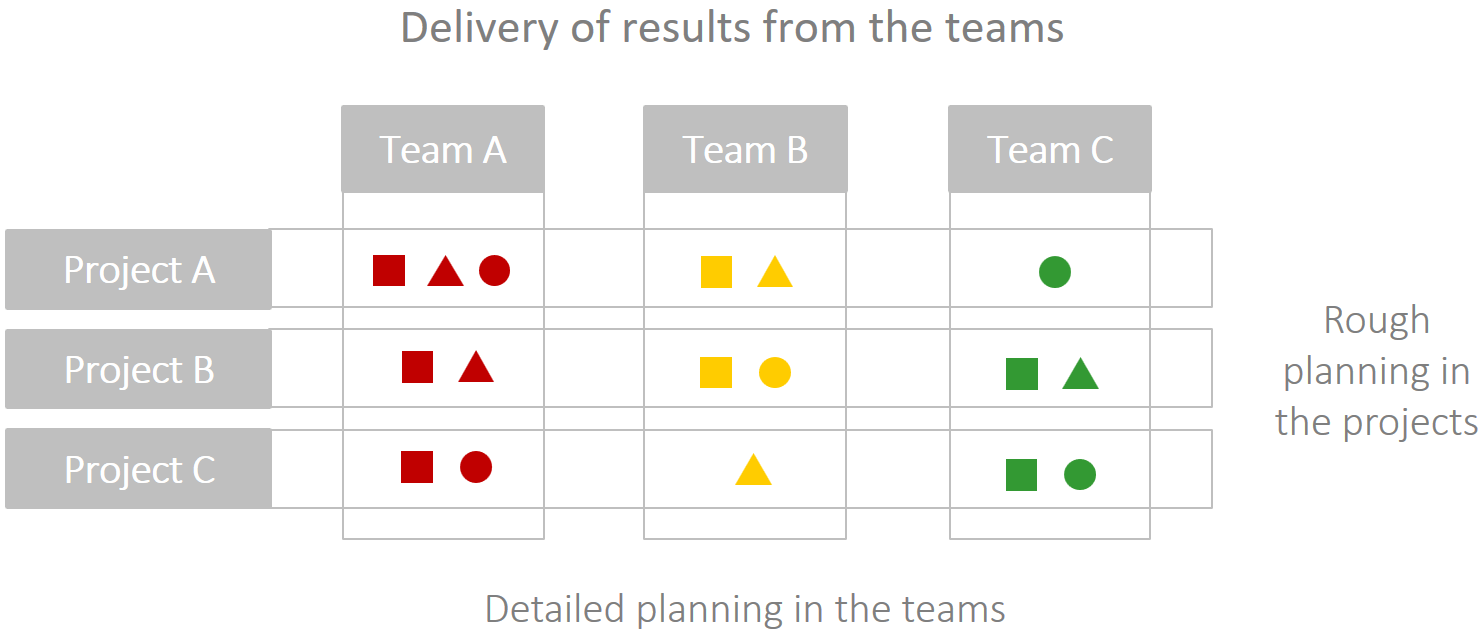
Which person is working on which task does not tend to matter to project managers. However, most project managers do want to co-determine who will be working on the requested delivery.
In the line organization, project managers and team leaders usually agree on requested deliverables for appointed delivery dates. Gratifying the project managers’ requests for particular staff members is certainly conducive to a good working atmosphere.
In this case, resource management remains with the team leaders for the most part. This can be seen as the advantage of this form of organization, as project managers are exempted from this activity.
On the other hand, it is a disadvantage that project managers lack direct access to the resources. In the worst case, they could be dissatisfied with the quality of the delivery.
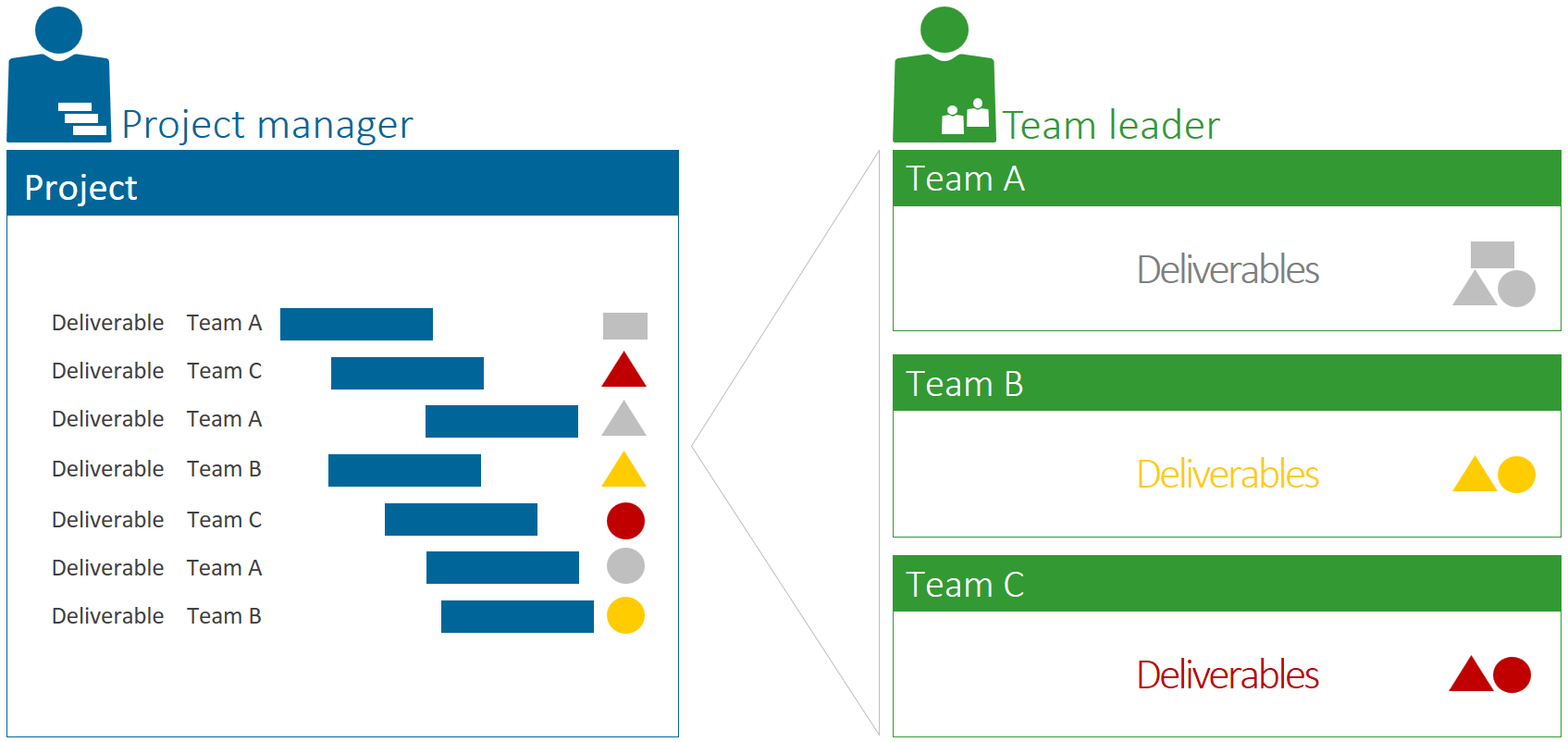
The responsibilities of the project manager in the line organization are mainly:
- Scheduling
- Agreeing with the team leaders on the results to be delivered
The team leader is also the resource planner planning the details at task level. This allows team leaders to coordinate delivery dates and efforts with the project managers. In this case, using a project planning tool tends to work well for the team leader. But this is on the condition that the tool supports the comfortable alignment of tasks and milestones between projects and sub-projects.
As a project manager in a line organization, you need to pay close attention to the structuring of the project plans. A neat project structure fosters the coordination with the team leaders.
Looking to introduce resource management? Read our detailed guide.
Controlling plans with inappropriate structures entails a high additional effort. This is avoidable. Moreover, there is a risk. You may not be able to identify undesirable schedule developments in good time due to lack of clarity.
Our tip: In a line organization, you need to pay close attention to the structuring of the project plans. In the course of the coordination, it is important to compare, or even link, deliverables to be produced by the teams with the team leaders’ planning. A neat project structure benefits the coordination and increases clarity.
Matrix Organization – Who Is Employed in Which Project? And When?
In the matrix organization, staff members from different teams are committed to project managers. To this end, project managers assign the desired staff members or even only skills / capabilities to the detailed tasks in their projects.
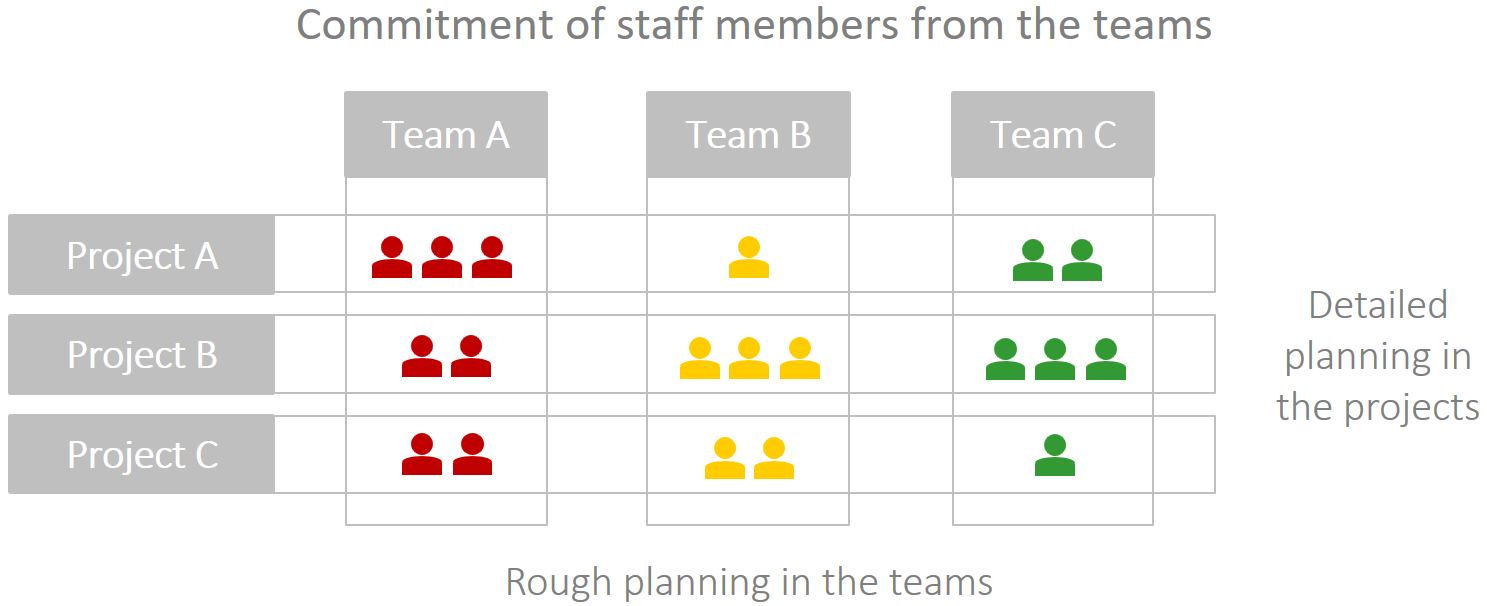
At project level, the sums of the assignments per person or skill are sent to the team leaders as requests. The team leaders need their own rough planning to be able to select and commit the requested resources.
After checking and selecting available and suitable team members, the team leaders commit them to the project managers. They enter the committed time periods roughly into their own planning per person and project.
The matrix organization has a drawback for the project managers. They can select the staff members for their project only to a limited extent. As long as the qualifications are adequate, this should be a secondary problem.
Read this article if you are interested in the resource planning process in line and matrix organizations.
The benefit for the project managers is that they can employ the team members freely in their project within the committed scope. When rescheduling, further alignments are unnecessary, as long as the agreed time frame is not exceeded.
Team leaders also benefit from the matrix organization. They are better able to look after the qualification and supervision of their team members. After all, they do not have to devote themselves to the detailed planning of the work packages.
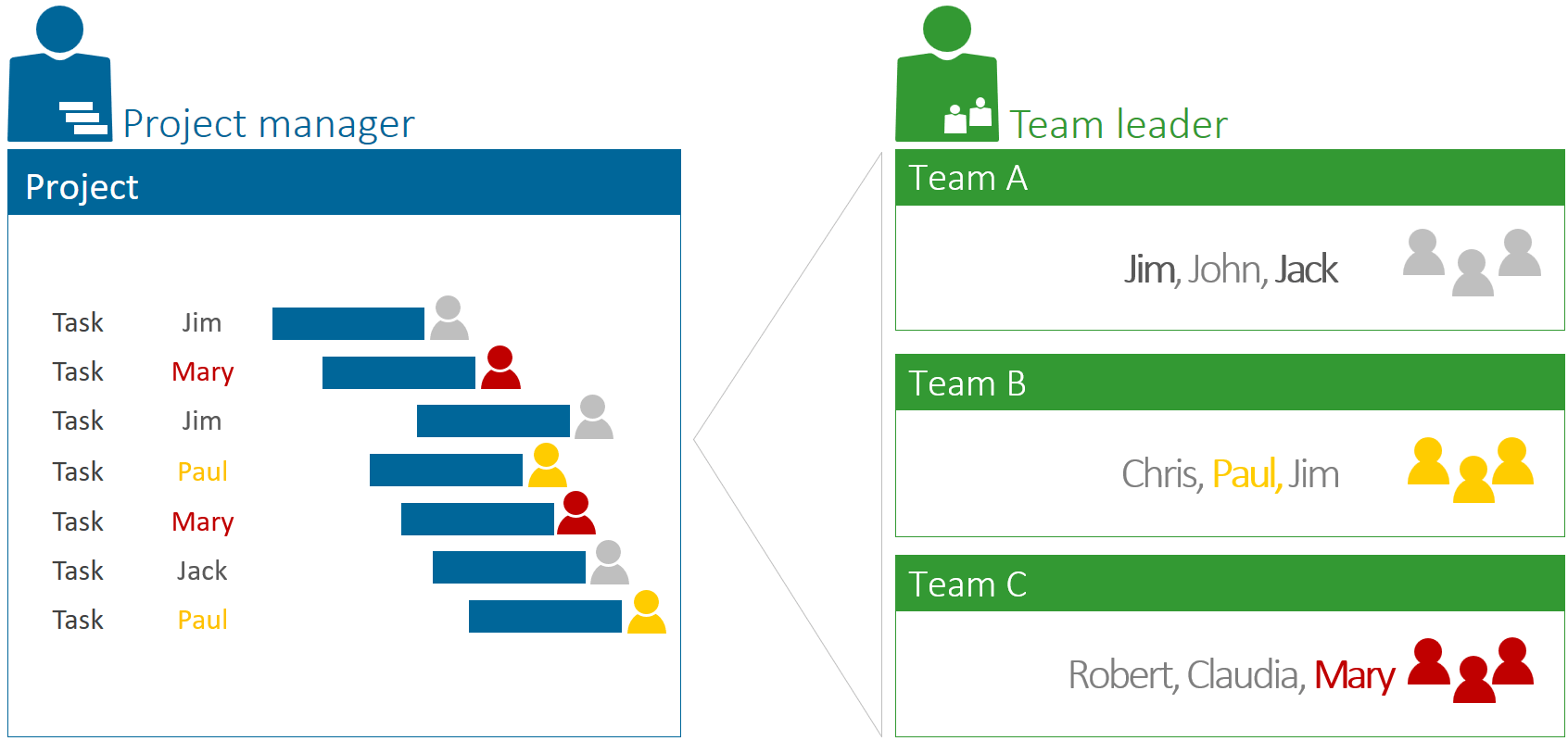
In this form of organization, project managers are thus occupied with the classic planning of tasks and resources. They have to coordinate the assignments of the resources with the team leaders at project level.
To be able to select and commit team members, team leaders need an appropriate overview of their own. Yet, they are unlikely to find this among the tools for project management. Therefore, the necessary coordination often takes place only verbally, by email, or via Excel.
This is the reason for the bulk of coordination problems. Team leaders must handle many requests. Plus, these requests often change again.
Hence, the following applies: as long as the team leaders lack a rough resource planning tool of their own, resource planning in the matrix organization will not succeed.
Frustrated with project management challenges and tools? Learn about the most important requirements for resource management software. Read article.
In a matrix organization, adequate coordination processes are essential due to the high effort for coordination. The same goes for the actually suitable tools project managers and team leaders have to use on a daily basis.
Both the coordination processes and the tools are indispensable conditions for this form of organization.
Our tip: Due to large efforts needed to coordinate, be sure to establish adequate coordination processes in a matrix organization. Provide the right tools, too – for the project managers as well as for the team leaders.
Resource Management Challenges according to PMO Survey 2020
In our 2020 PMO Survey, we questioned 330 companies with an established PMO. The respondents widely regarded resource management as an important challenge.
Only 9% of the companies responded that tactical resource planning with assistance from the PMO was already well-established, see “Coordination of project manager and team leader” in the figure below. By contrast, 45% were either planning improvements in this area or intended start efforts in this direction in the next 12 months.
This demonstrates that many companies have realized just how central good tactical resource planning is to successful project management.
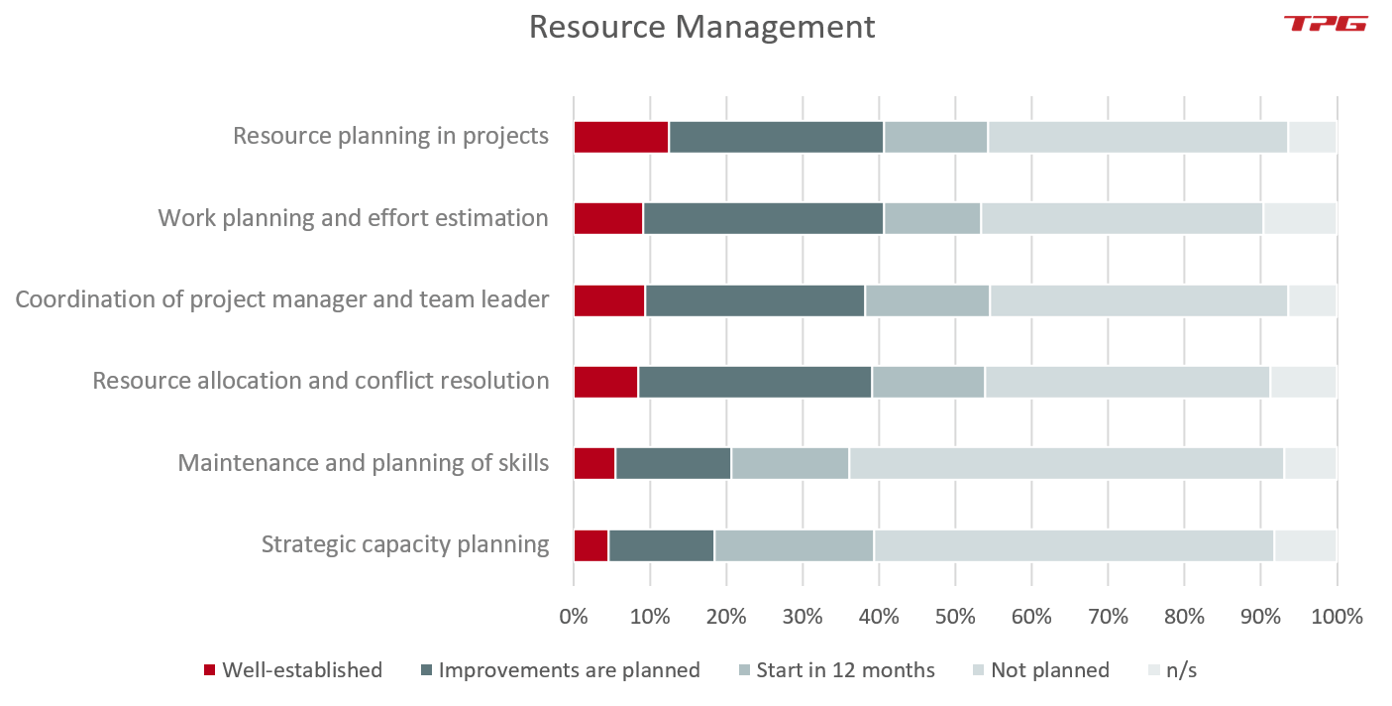
Conclusion – The Challenges of Tactical Resource Planning
This article has introduced you to the particular challenges of tactical resource planning. Team leaders and project managers have different tasks and look at the same people from different angles.
The team leader wants to see the members of the team well occupied and trained. The project manager, on the other hand, wants to complete the project on schedule and in the necessary quality. The two do not always see eye-to-eye: the project manager does not always get the desired staff members with the best qualifications.
The challenge of tactical resource planning is to reconcile the two perspectives. Depending on the form of organization, the planning of team leaders and project managers will differ, too.
In the line organization, the project managers receive results from the teams. In the matrix organization, staff members from the teams are made available to the project managers.
Team leaders in the matrix organization must handle many requests from the projects. And these requests often change again. This is the reason for the bulk of coordination problems. In this case, team leaders require their own rough planning tool.
Which challenges of resource scheduling have you encountered? Is there anything you would like to add? Please leave a comment below.
About the author: Johann Strasser, a certified engineer, has been a managing partner at TPG The Project Group since 2001. After many years as a development engineer in the automotive and energy sectors, Johann Strasser spent a decade as an independent trainer and consultant in the field of project management. During his tenure, he also served as project manager for software projects in the construction industry and provided scheduling and cost management support for large-scale construction projects. At TPG, he applies his expertise in product development and consulting services for international clients. His special focus is on PMO, project portfolios, hybrid project management, and resource management. For many years now, he has shared his knowledge through presentations, seminars, articles, and webinars.
You can read more about Johann Strasser on LinkedIn and XING.







